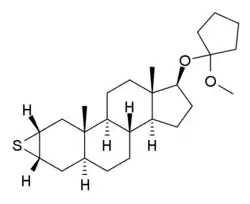Mepitiostane
Mepitiostane, sold under the brand name Thioderon, is an orally active antiestrogen and anabolic–androgenic steroid (AAS) of the dihydrotestosterone (DHT) group which is marketed in Japan as an antineoplastic agent for the treatment of breast cancer.[1][2][3][4][5] It is a prodrug of epitiostanol.[6][7] The drug was patented and described in 1968.[1]
 | |
| Clinical data | |
|---|---|
| Trade names | Thioderon |
| Other names | 10364-S; Epitiostanol 17β-(1-methoxy)cyclopentyl ether; 17β-[(1-Methoxycyclopentyl)oxy]-2α,3α-epithio-5α-androstane |
| AHFS/Drugs.com | International Drug Names |
| Routes of administration | By mouth |
| Drug class | Androgen; Anabolic steroid; Androgen ether; Antiestrogen |
| ATC code |
|
| Legal status | |
| Legal status |
|
| Identifiers | |
| |
| CAS Number | |
| PubChem CID | |
| ChemSpider | |
| UNII | |
| KEGG | |
| Chemical and physical data | |
| Formula | C25H40O2S |
| Molar mass | 404.65 g·mol−1 |
| 3D model (JSmol) | |
| |
| |
| | |
Medical uses
Mepitiostane is used as an antiestrogen and antineoplastic agent in the treatment of breast cancer.[1][2][3][5] It is also used as an AAS in the treatment of anemia of renal failure.[5] A series of case reports have found it to be effective in the treatment of an estrogen receptor (ER)-dependent meningiomas as well.[8][9][10][11]
Side effects
Mepitiostane shows a high rate of virilizing side effects such as acne, hirsutism, and voice changes in women.[12]
Pharmacology
Pharmacodynamics
Mepitiostane is described as similar to tamoxifen as an antiestrogen,[8] and through its active form epitiostanol, binds directly to and antagonizes the ER.[13][14][15][16] It is also an AAS.[1][3]
Pharmacokinetics
Mepitiostane is converted into epitiostanol in the body.[6][7]
Chemistry
Mepitiostane, also known as epitiostanol 17β-(1-methoxy)cyclopentyl ether,[6] is a synthetic androstane steroid and a derivative of DHT.[1][2][3] It is the C17β (1-methoxy)cyclopentyl ether of epitiostanol, which itself is 2α,3α-epithio-DHT or 2α,3α-epithio-5α-androstan-17β-ol.[6][7] A related AAS is methylepitiostanol (17α-methylepitiostanol), which is an orally active variant of epitiostanol similarly to mepitiostane, though also has a risk of hepatotoxicity.[17]
Society and culture
References
- J. Elks (14 November 2014). The Dictionary of Drugs: Chemical Data: Chemical Data, Structures and Bibliographies. Springer. p. 768. ISBN 978-1-4757-2085-3.
- Index Nominum 2000: International Drug Directory. Taylor & Francis. January 2000. pp. 648–. ISBN 978-3-88763-075-1.
- I.K. Morton; Judith M. Hall (6 December 2012). Concise Dictionary of Pharmacological Agents: Properties and Synonyms. Springer Science & Business Media. pp. 175–. ISBN 978-94-011-4439-1.
- "Mepitiostane".
- Allan J. Erslev (1991). Erythropoietin: molecular, cellular, and clinical biology. Johns Hopkins University Press. p. 229. ISBN 978-0-8018-4221-4.
- Valentino Stella; Ronald Borchardt; Michael Hageman; Reza Oliyai; Hans Maag; Jefferson Tilley (12 March 2007). Prodrugs: Challenges and Rewards. Springer Science & Business Media. pp. 660–. ISBN 978-0-387-49782-2.
- Ronald T. Borchardt; Philip L. Smith; Glynn Wilson (29 June 2013). Models for Assessing Drug Absorption and Metabolism. Springer Science & Business Media. pp. 101–. ISBN 978-1-4899-1863-5.
- Herbert B. Newton (19 December 2005). Handbook of Brain Tumor Chemotherapy. Academic Press. pp. 470–. ISBN 978-0-08-045593-8.
- Joung H. Lee (11 December 2008). Meningiomas: Diagnosis, Treatment, and Outcome. Springer Science & Business Media. pp. 293–5. ISBN 978-1-84628-784-8.
- Oura, Shoji; Sakurai, Takeo; Yoshimura, Goro; Tamaki, Takeshi; Umemura, Teiji; Kokawa, Yozo; Masuo, Osamu; Naito, Yasuaki (2000). "Regression of a presumed meningioma with the antiestrogen agent mepitiostane". Journal of Neurosurgery. 93 (1): 132–135. doi:10.3171/jns.2000.93.1.0132. ISSN 0022-3085. PMID 10883917.
- Miyai M, Takenaka K, Hayashi K, Kato M, Uematsu K, Murai H (2014). "[Effect of an oral anti-estrogen agent (mepitiostane) on the regression of intracranial meningiomas in the elderly]". Brain Nerve (in Japanese). 66 (8): 995–1000. PMID 25082321.
- Inoue K, Okazaki K, Morimoto T, Hayashi M, Uyama S, Sonoo H, Koshiba Y, Takihara T, Nomura Y, Yamagata J, Kondo H, Kanda K, Takenaka K (1978). "Therapeutic value of mepitiostane in the treatment of advanced breast cancer". Cancer Treat Rep. 62 (5): 743–5. PMID 657160.
- Matsuzawa A, Yamamoto T (1977). "Antitumor effect of two oral steroids, mepitiostane and fluoxymesterone, on a pregnancy-dependent mouse mammary tumor (TPDMT-4)". Cancer Res. 37 (12): 4408–15. PMID 922732.
- H. Timmerman (20 November 1995). QSAR and Drug Design: New Developments and Applications. Elsevier. pp. 125, 145. ISBN 978-0-08-054500-4.
- INTERNATIONAL REVIEW OF CYTOLOGY. Academic Press. 27 June 1986. pp. 319–. ISBN 978-0-08-058640-3.
- Croll, Roger P.; Wang, Chunde (2007). "Possible roles of sex steroids in the control of reproduction in bivalve molluscs". Aquaculture. 272 (1–4): 76–86. doi:10.1016/j.aquaculture.2007.06.031. ISSN 0044-8486.
- Rahnema, C. D.; Crosnoe, L. E.; Kim, E. D. (March 2015). "Designer steroids – over-the-counter supplements and their androgenic component: review of an increasing problem". Andrology. 3 (2): 150–155. doi:10.1111/andr.307. ISSN 2047-2927. PMID 25684733. S2CID 6999218.